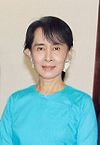- Burmese general election, 1990
-
Burmese (Myanma) general election, 1990 
1960 ← 27 May 1990 → 2010 All 492 seats to the Burmese Parliament First party Second party Third party 


Leader Aung San Suu Kyi U Tha Gyaw Khun Htun Oo Party NLD NUP SNLD Seats won 392 10 23 Popular vote 7,943,622 2,805,559 222,821 Percentage 58.7% 21.2% 1.7%
Prime Minister before election
Prime Minister-designate
Saw Maung
Military
Aung San Suu Kyi (not recognize)
NLDBurma (Myanmar) 
This article is part of the series:
Politics and government of
BurmaGovernment Assembly of the Union
(House of Nationalities and
House of Representatives)
Political parties
USDP · SNDP · NUP · NDF · RNDPCabinet
President (List): Thein Sein
Vice Presidents:
Tin Aung Myint Oo
and Sai Mauk KhamSupreme Court
Chief Justice: Tun Tun Oo
Constitutional Tribunal
Chairman: Tin AyeElections General elections
1960 • 1990 • 2010 • 2015Related topics Foreign relations
Human rights
Naming issues
Administrative divisions
(Districts • Townships)
General elections were held in Burma on 27 May 1990, the first multi-party elections since 1960, after which the country had been ruled by a military dictatorship. The elections were not meant to form a parliamentary government, but rather to form a parliament sized constitutional committee to draft a new constitution.[1]
The elections were won convincingly by Aung San Suu Kyi's National League for Democracy (NLD), who took 392 of the 492 seats. However, the military junta refused to recognize the results, and have since ruled the country as the State Peace and Development Council. Voter turnout was 72.6%.[2]
Contents
Background
The aftermath of the uprising in 1988 and the rise of leader Aung San Suu Kyi placed worldwide media attention on the political situation in Burma.[3] In September 1988, the State Law and Order Restoration Council (SLORC, the predecessor to the State Peace and Development Council), in its Declaration No. 1, had set four goals for the country: to maintain law and order, improve transportation, improve the humanitarian situation and hold multi-party elections.[4] It also stated that the military would not "cling to power for long".[4] Suu Kyi had been calling for dialogue between the SLORC and the citizens of Burma.[5] In May 1989, the government reopened universities that had been involved in the uprising the previous year. At the same time, the government conceded and a date for the election was set for May 1990 with political parties registering for the election immediately.[6] The date, 27 May 1990, was chosen for its auspicious nature surrounding the number 9; 27 May (2+7=9), and on the fourth Sunday of the fifth month (4+5=9).[7]
Parties and campaigning
93 political parties presented a total of 2,297 candidates to contest the 492 constituencies, with at least 2 candidates per constituency.[8] Of the 93, 19 different ethnic parties also took part in the election.[9] The National Unity Party (NUP) was favoured by the party to win.[8] Suu Kyi, a popular opposition figure, ran against General Ne Win's largely disliked associate, Sein Lein.[10] The symbol for the NUP was a sheaf of rice stalks, and the NLD's was a straw hat.[11] Some people took to wearing rice stalks around their bare feet, a grave insult in a Buddhist country.[11]
Although election campaigning was underway, the government placed restrictions on opposition politicians. U Aung Gyi, a former member of the junta, was expected to lead a weak coalition that would not challenge the interests of the army. He was imprisoned in 1988 for his outspoken views against the regime, but criticised Suu Kyi for being a "radical manipulated by Communists".[11] Former Prime Minister U Nu remained under house arrest during the election process,[12] as was Suu Kyi since 20 July 1989, without trial.[13] Throughout campaigning, the government kept its restrictions on public gatherings and political meetings, and required all political literature to be approved by the SLORC prior to publication; however political parties defied the ruling.[14] Two days before the election, visas for 61 foreign journalists were unexpectedly issued to cover the vote.[8]
Results
The National League for Democracy won 392 out of 492 seats that were in the end contested; the junta's party (NUP) came second in terms of vote share (21%) but fourth in seats (10).[8]
Party Votes % Seats National League for Democracy 7,930,841 59.9 392 National Unity Party 3,312,122 21.2 10 Shan Nationalities League for Democracy 220,835 1.7 23 United Nationals Democracy Party 182,752 1.5 1 Rakhine Democratic League 157,255 1.2 11 Mon National Democratic Front 135,874 1.1 5 National Democratic Party for Human Rights 128,129 1.0 4 Democracy Party 63,387 0.5 1 Party for National Democracy 61,791 0.5 3 Chin National League for Democracy 51,277 0.4 3 Union Paoh National Organisation 43,214 0.3 3 Arkan People's Democratic Front 31,620 0.3 0 Union Danu League for Democracy Party 23,145 0.2 1 Ta-ang National League for Democracy 22,223 0.2 2 Democratic Organisation for Kayah National Unity 16,580 0.1 2 Lahu National Development Party 15,794 0.1 1 Kachin State National Congress for Democracy 13,994 0.1 3 Mro (Khami) National Solidarity Organisation 12,578 0.1 1 Zomi National Congress 12,372 0.1 2 Kaya State Nationalities League for Democracy 11,664 0.1 2 Naga Hills Regional Progressive Party 10,612 0.1 2 Kaman National League for Democracy 10,596 0.1 1 Graduates and Old Students Democratic Association 10,508 0.1 1 United Nationalities League for Democracy 8,929 0.1 1 Shan State Kokango Democratic Party 7,392 0.1 1 Karen State National Organisation 6,401 0.1 1 Mara People's Party 592,958 4.5 1 Patriotic Old Comrades' League 1 61 other parties 0 Independents 151,763 1.1 6 Vacant - - 7 Invalid/blank votes 1,865,918 - - Total 15,112,524 100 492 Source: Nohlen et al. Aftermath
Initially, the junta said it would honour the results of the election, but would not relinquish power until a new constitution had been drafted, which could take up to two years.[15] However later the government, surprised at the outcome, annulled the results and many opposition politicians went into exile, with some forming the National Coalition Government of the Union of Burma.[16] Two months after the election, the SLORC issued Order 1/90, explaining it had legitimacy to rule as it was recognised by the United Nations and individual countries, as well as ensuring it would prevent the breakup of the Union.[17] It required all parties to recognise and accept the Order, and many opposition figures who refused were arrested.[17]
References
- ^ Steinberg, David (2010). Burma/Myanmar - What Everyone Needs to Know. Oxford University Press. pp. 90–93. ISBN 978-0-19-539067-4.
- ^ Nohlen, D, Grotz, F & Hartmann, C (2001) Elections in Asia: A data handbook, Volume I, p611 ISBN 019924958
- ^ Reid, Robert; Grosberg, Michael (2005). Myanmar (Burma). Lonely Planet. pp. 35. ISBN 978-1740596954.
- ^ a b Guyot, James F (1991). "Myanmar in 1990: The unconsummated election". Asian Survey (University of California Press) 31 (2): 205–211. JSTOR 2644932.
- ^ Ling, Bettina (1999). Aung San Suu Kyi: standing up for democracy in Burma. Feminist Press. p. 62. ISBN 978-1558611962.
- ^ Ling, 1999, p. 63.
- ^ Perry, Peter John (2007). Myanmar (Burma) since 1962: the failure of development. Ashgate Publishing, Ltd. pp. 43. ISBN 978-0754645344.
- ^ a b c d Eur (2002). Far East and Australasia 2003. Routledge. pp. 863. ISBN 978-1857431339.
- ^ Steinberg, David I (2001). Burma, the state of Myanmar. Georgetown University Press. pp. 46. ISBN 978-0878408931.
- ^ Ludwig, Arnold M (2004). King of the Mountain: The Nature of Political Leadership. University Press of Kentucky. pp. 106. ISBN 978-0813190686.
- ^ a b c Erlanger, Steven (1 April 1990). "The Burmese Are Going to Vote; the Army Tells Them To". The New York Times. http://www.nytimes.com/1990/04/01/weekinreview/the-world-the-burmese-are-going-to-vote-the-army-tells-them-to.html.
- ^ Erlanger, Steven (27 May 1990). "Burmese Vote Today, or Do They?". The New York Times. http://www.nytimes.com/1990/05/27/world/burmese-vote-today-or-do-they.html.
- ^ Silverstein, Josef (1996). "The Idea of Freedom in Burma and the Political Thought of Daw Aung San Suu Kyi". Pacific Affairs 69 (2): 211–228. http://charlesesalazar.pbworks.com/f/The+idea+of+freedom+in+burma+and+the+pol+thought+of+aung+sang+suu+kyi.pdf.
- ^ Ling, 1999, p. 64.
- ^ Anderson, Jack (11 June 1990). "Even with elections, Burma is slow to change". Kentucky New Era. http://news.google.co.uk/newspapers?id=FvMrAAAAIBAJ&sjid=PmoFAAAAIBAJ&pg=5882,3863425&dq=.
- ^ Gravers, Mikael (1999). Nationalism as political paranoia in Burma: an essay on the historical practice of power (2 ed.). Taylor & Francis. pp. 69. ISBN 978-0700709816.
- ^ a b Eur, 2003, p. 864.
General elections Referendums 1973 · 2008Categories:- 1990 elections in Asia
- Elections in Burma
- 1990 in Burma
Wikimedia Foundation. 2010.
